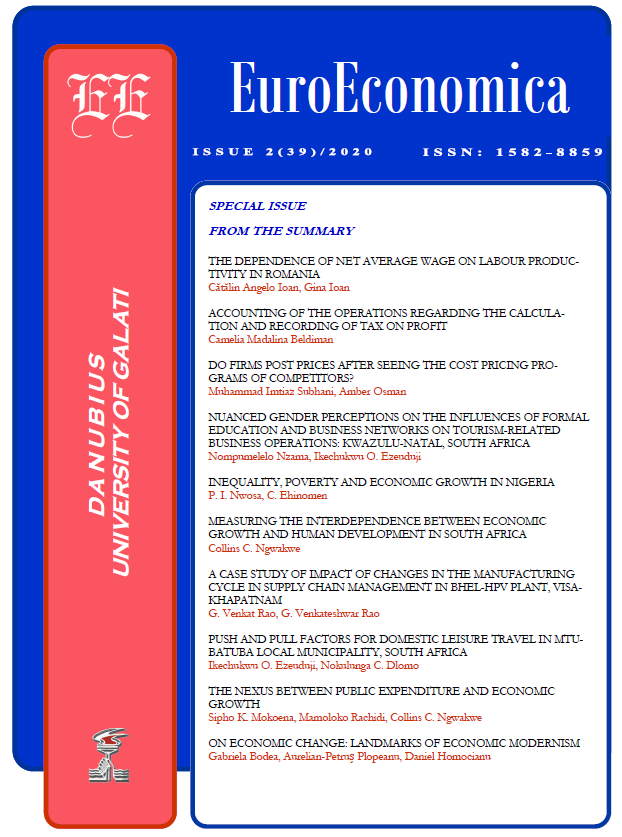Does the Diversification of the Economy Matter? An Assessment of the Situation in South Africa
Keywords:
Diversification; economic development; GDP; South AfricaAbstract
Globally, it is an acceptable principle that a more diverse economy, where economic activity is spread across all economic sectors, has a better chance to survive external shocks and is much more resilient than more sectoral concentrated economies. Developing countries are struggling in this process of diversification as this process requires structural changes in the economy with improved technology, productivity and skills levels. The objective of this study was to assess the relationship between economic diversification and economic growth and development in a developing country. South Africa was selected due to the fact that it is the most advanced economy in Africa with well-developed economic sectors. The methodology is quantitative in nature and panel time series data were collected from 1996 to 2018 for all nine provinces in South Africa. The relationship between selected variables were econometrically tested using two different models with GDP per capita and a diversification index as dependent variables respectively. Other variables included in the models were annual household income and income inequality (Gini Coefficient). The results indicated that there is a long-run relationship between all variables and that diversification does positively impact on GDP per capita, as well as rise in household income. The results also indicated that GDP per capita also impacts positively on the level of diversification of the economy. In terms of causality on the short-run, GDP per capita causes improvements in diversification. It can therefore be concluded that a positive relationship has been identified between economic diversification and economic growth and development in South Africa and that a policy for increased diversification across all economic sectors is a viable economic development strategy that should be implemented by developing countries.
References
Brooks, C. (2014). Introductory econometrics and finance. 3rd Edition. Cambridge: Cambridge University Press.
Brown, C. C. (2012). The impact of changing diversification on stability and growth in a regional economy. Research in Business and Economics Journal, p. 5.
Economic Commission for Latin America and the Caribbean (ECLAC). (2017). Economic diversification. Available at https://repositorio. cepal. org/bitstream/handle/11362/42399/FOCUSIssue2Apr-Jun2017. pdf (accessed: 13 May 2020).
Esanov, A. (2012). Economic diversification: dynamics, determinants and policy implications. Revenue Watch Institute, p. 8.
Esu, G. E. & Udonwa, U. (2015). Economic diversification and economic growth: Evidence from Nigeria. Journal of Economics and Sustainable Development, 6(16), pp 56-68.
Freire, C. (2017). Economic diversification: Explaining the pattern of diversification in the global economy and its implications for fostering diversification in poorer countries. United Nations, Department of Economic and Social Affairs.
Gelb, A. (2010). Economic Diversification in Resources Rich Countries. Washington, D. C. : Centre for Global Development.
Global Insight. (2020). Regional explorer data. Johannesburg. South Africa.
Gylfason, T. (2016). From economic diversification to growth. In forthcoming in a proceedings volume from a High Level Seminar on Natural Resources, Finance & Growth sponsored by Bank of Algeria, Algiers.
Hammouda, H. B.; Karingi, S. N.; Njuguna, A. E. & Jallab, M. S. (2010). Growth, productivity and diversification in Africa. Journal of Productivity Analysis, 33(2), pp. 125-146.
Hausmann, R. & Hidalgo, C. (2011). The network structure of economic output. Journal of Economic Growth, 16(4), p. 309-342.
Kapunda, S. M. (2003). Diversification and poverty eradication in Botswana. Pula: Botswana. Journal of African Studies, 17(2), pp. 51-57.
Lei, H. & Zhang, J. (2014). Capabilities’s substitutability and the “S” curve of export diversity. EPL. Europhysics Letters, 105 (6), pp. 68003.
Madjd-Sadjadi, Z. (2019). Economic diversification. Avaiable at https://www. quora. com/What-is-the-definition-of-economic-diversification. (Accessed: 13 May 2020).
OECD. (2019). Aid for trade at a glance 2019: Economic diversification and empowerment. Available at https://www. wto. org/english/res_e/booksp_e/aid4trade19_chap5_e. pdf. (accessed: 13 May 2020).
Pedroni, P. (2000). Fully modified OLS for heterogeneous cointegrated panels. Advances in Econometrics, 15, pp. 93-130.
Pirasteh, H.; Sayadi, M. & Saghafi, M. (2009). Economic Growth and Stability in the Euro-Med Region: Concentration or Diversification? Iranian Economic Review, 14(23).
Riti, J. S.; Gubak, H. D. & Madina, D. A. (2016). Growth of non-oil sectors: A key to diversification and economic performance in Nigeria. Public Policy and Administration Research, 6(3), pp. 64-75.
Sauvé, P. (2019). Gendered Perspectives on Services Trade and Investment, Mimeo. Paper prepared as background for a joint World Bank Group-World Trade Organization report on Trade and Gender. Geneva: World Bank Group
Sharpley, R. (2002). The challenges of economic diversification through tourism: the case of Abu Dhabi. International Journal of Tourism Research, 4(3), pp. 221-235.
Shayah, M. H. (2015). Economic diversification by boosting non-oil exports (case of UAE). Journal of Economics and Business Management. 3(7), pp. 735-738.
Sheng, L. (2011). Specialisation versus diversification: A simple model for tourist cities. Tourism Management, 32(5), pp. 1229-1231.
Tintin, C. (2009). Testing the Balassa-Samuelson Hypothesis: Evidence from 10 OECD Countries. Lund University (Masters thesis).
Yusof, Z. (2013). Economic Diversification: The Case of Malaysia. Revenue Watch Institute.
How to Cite
Issue
Section
License
The author fully assumes the content originality and the holograph signature makes him responsible in case of trial.


